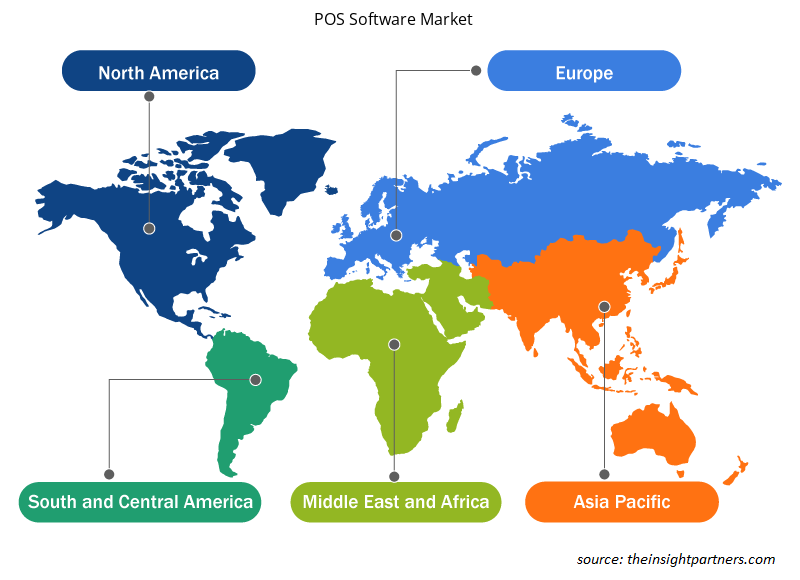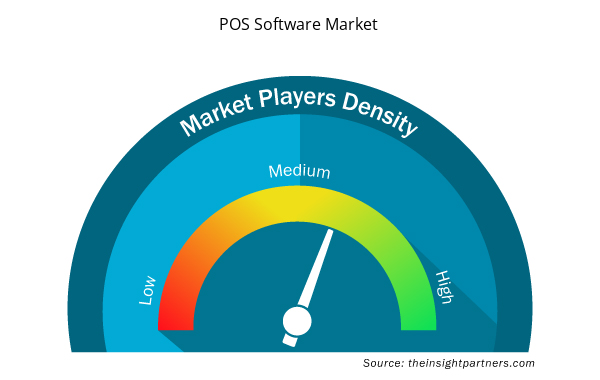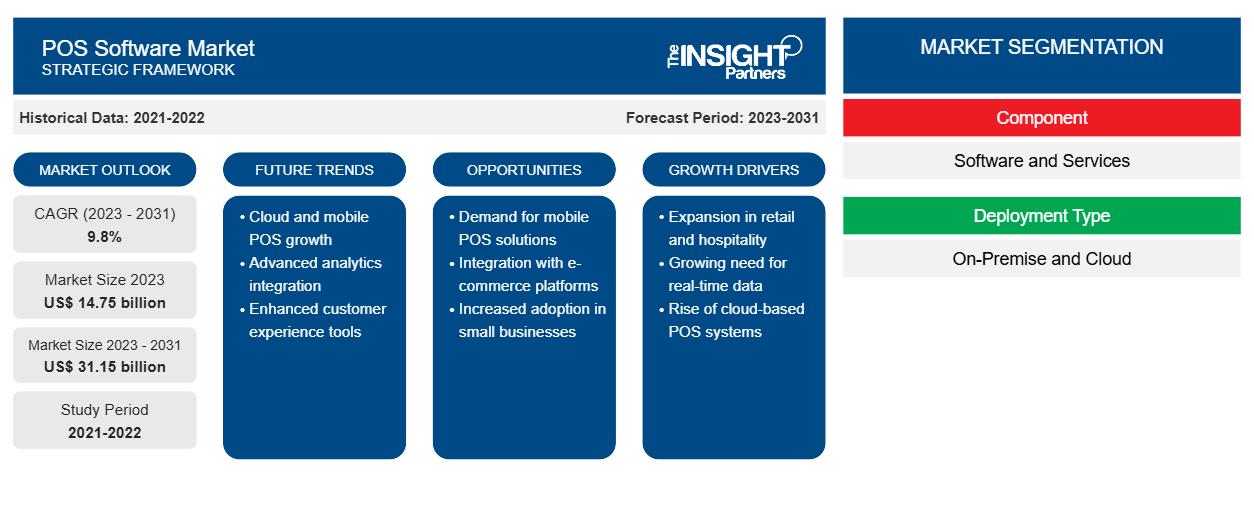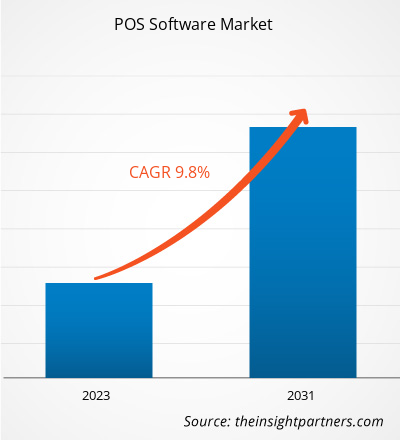Das Marktvolumen für POS- Software soll von 14,75 Milliarden US-Dollar im Jahr 2023 auf 31,15 Milliarden US-Dollar im Jahr 2031 anwachsen. Von 2023 bis 2031 wird eine durchschnittliche jährliche Wachstumsrate (CAGR ) von 9,8 % erwartet. Die zunehmende Nutzung von Cloud-Computing-Diensten dürfte ein wichtiger Trend auf dem POS- Softwaremarkt bleiben.
Marktanalyse für POS -Software
Die Notwendigkeit, bargeldlose Transaktionen durchzuführen, Verkaufs- und Bestandsdaten zu verfolgen und Analysen zu nutzen, um die Verkaufsstrategie in Einzelhandelsketten, Restaurants, Hotels, Drogerien, Autowerkstätten und anderen Orten zu optimieren, hat die Nachfrage nach Point-of-Sale-Software ( POS ) angetrieben. Es wird erwartet, dass die Verwendung von POS -Software in einer Vielzahl von Branchen aufgrund der steigenden Nachfrage nach erweiterten Funktionen wie Kundendatenverwaltung, Bestandsverfolgung, Verkaufsüberwachung, Mitarbeiterverwaltungsanalyse und Berichterstellung zunehmen wird. Darüber hinaus könnte die steigende Nachfrage nach cloudbasierter mobiler Point-of-Sale-Software auf die wachsende Akzeptanz cloudbasierter Lösungen zurückzuführen sein.
Marktübersicht für POS -Software
Point-of-Sale-Software ( POS ) ist eine spezielle Anwendung, die Unternehmen zur Durchführung von Transaktionen an der Verkaufsstelle verwenden, typischerweise im Einzelhandel. Indem sie Verkäufe nachverfolgt, Lagerbestände kontrolliert und Zahlungen abwickelt, beschleunigt sie den Bezahlvorgang. Um Genauigkeit zu gewährleisten, wird Point-of-Sale-Software häufig mit Hardware wie Barcode- Lesegeräten , Registrierkassen und Kartenlesern verbunden. Darüber hinaus verfügt sie über Tools zur Handhabung von Kundeninformationen, zur Erstellung von Verkaufsberichten und zur Auswertung.
Passen Sie diesen Bericht Ihren Anforderungen an
Sie erhalten kostenlos individuelle Anpassungen an jedem Bericht, einschließlich Teilen dieses Berichts oder einer Analyse auf Länderebene, eines Excel-Datenpakets sowie tolle Angebote und Rabatte für Start-ups und Universitäten.
- Holen Sie sich die wichtigsten Markttrends aus diesem Bericht.Dieses KOSTENLOSE Beispiel umfasst eine Datenanalyse von Markttrends bis hin zu Schätzungen und Prognosen.
Treiber und Chancen auf dem POS- Softwaremarkt
Wachsende E-Commerce-Branche
Angesichts der zunehmenden Verbreitung von Online- und Omnichannel -Shopping benötigen Unternehmen Point-of-Sale-Software ( POS ), die ihre Offline- und Online-Vertriebskanäle nahtlos miteinander verbinden kann. Dies treibt die Nachfrage nach Point-of-Sale-Systemen ( POS ) voran, die Funktionen wie Bestandskontrolle, Auftragsabwicklung und Kundenbeziehungsmanagement ( CRM ) umfassen, was wiederum das Wachstum des POS- Softwaremarktes vorantreibt.
Steigende Nachfrage nach Business Intelligence und Data Analytics
Point-of-Sale-Software ( POS ) wird von Unternehmen zunehmend als Tool verwendet, um Daten zu Verkäufen, Kundenverhalten, Lagerbeständen und Mitarbeiterleistung zu sammeln und zu untersuchen. Ausgefeilte Analyse- und Berichtstechnologien können Unternehmen dabei helfen, datengesteuerte Entscheidungen zu treffen, die Kundenzufriedenheit zu erhöhen und den Arbeitsaufwand zu reduzieren. Daher wird erwartet, dass diese Vorteile der POS -Software das Marktwachstum im Prognosezeitraum vorantreiben werden .
Segmentierungsanalyse des POS-Software-Marktberichts
Wichtige Segmente, die zur Ableitung der POS-Software-Marktanalyse beigetragen haben, sind Komponente (Software und Dienste); Bereitstellungstyp (vor Ort und in der Cloud); Anwendung und Endbenutzer
- Basierend auf den Komponenten ist der POS-Softwaremarkt in Software und Dienstleistungen unterteilt. Das Softwaresegment hatte im Jahr 2023 einen größeren Marktanteil.
- Basierend auf der Bereitstellungsart ist der Markt in On-Premise und Cloud unterteilt. Das On-Premise-Segment hatte im Jahr 2023 einen größeren Marktanteil.
- Basierend auf der Anwendung ist der Markt in Bestandsverfolgung, Einkaufsmanagement, Verkaufsberichte, Kundenbindung und andere unterteilt. Das Segment Bestandsverfolgung hatte im Jahr 2023 einen größeren Marktanteil.
- Nach Endverbraucher ist der Markt in Einzelhandel, Gastgewerbe, Medien und Unterhaltung, Gesundheitswesen und andere segmentiert. Das Einzelhandelssegment hielt im Jahr 2023 den größten Marktanteil.
Marktanteilsanalyse für POS-Software nach geografischer Lage
Der geografische Umfang des POS-Software-Marktberichts ist hauptsächlich in fünf Regionen unterteilt:Nordamerika, Asien-Pazifik, Europa, Naher Osten und Afrika sowie Südamerika/Süd- und Mittelamerika.
In Bezug auf den Umsatz hatte Nordamerika den größten Marktanteil im Bereich POS-Software. Der Markt in dieser Region ist in die USA, Kanada und Mexiko unterteilt. In der Region gibt es eine Reihe bekannter Hersteller von POS-Software sowie eine hohe Nachfrage nach komplexer integrierter POS-Software. Darüber hinaus erlebt der Einzelhandel in der Region ein enormes Wachstum, was das Wachstum des Marktes ankurbelt. Darüber hinaus wird erwartet, dass die US-Gesundheitsbranche aufgrund der Notwendigkeit, die Krankenhauseinrichtungen in Bezug auf Versicherung, Zahlung und Patientenmanagement zu modernisieren, am schnellsten wächst.
Neuigkeiten und aktuelle Entwicklungen zum POS-Softwaremarkt
Der POS-Softwaremarkt wird durch die Erfassung qualitativer und quantitativer Daten nach Primär- und Sekundärforschung bewertet, die wichtige Unternehmensveröffentlichungen, Verbandsdaten und Datenbanken umfasst. Im Folgenden finden Sie eine Liste der Entwicklungen auf dem Markt für Sprach- und Sprechstörungen und -strategien:
- US Bank, ein Branchenführer im Bereich Zahlungsdienste, hat die Einführung von Avvance angekündigt, einer eingebetteten, mehrkanaligen Point-of-Sale-Kreditlösung. Avvance ermöglicht Unternehmen, Verbraucherfinanzierungen während des Bezahlvorgangs mit einer schnellen Beantragung und sofortiger Entscheidung anzubieten. (Quelle: Elavon Inc., Pressemitteilung, 2023)
- NCR Corporation hat NCR Aloha Cloud vorgestellt, eine cloudbasierte Point-of-Sale-Lösung (POS), die robust genug ist, um unter der branchenführenden Marke Aloha auf den Markt zu kommen. Aloha Cloud bietet eine aktualisierte Benutzeroberfläche (UI), das kleinste Handheld-Gerät auf dem Markt und eine nahtlose Zahlungsabwicklung mit Einzahlungsbegleichung am nächsten Tag, sodass die Betreiber mehr Zeit haben, sich auf den Betrieb ihres Restaurants zu konzentrieren. (Pressemitteilung, 2022)
Regionale Einblicke in den POS-Softwaremarkt
Die regionalen Trends und Faktoren, die den POS-Softwaremarkt im Prognosezeitraum beeinflussen, wurden von den Analysten von Insight Partners ausführlich erläutert. In diesem Abschnitt werden auch die Marktsegmente und die Geografie von POS-Software in Nordamerika, Europa, im asiatisch-pazifischen Raum, im Nahen Osten und Afrika sowie in Süd- und Mittelamerika erörtert.

- Erhalten Sie regionale Daten zum POS-Softwaremarkt
Umfang des POS-Software-Marktberichts
| Berichtsattribut | Details |
|---|---|
| Marktgröße im Jahr 2023 | 14,75 Milliarden US-Dollar |
| Marktgröße bis 2031 | 31,15 Milliarden US-Dollar |
| Globale CAGR (2023 - 2031) | 9,8 % |
| Historische Daten | 2021-2022 |
| Prognosezeitraum | 2023–2031 |
| Abgedeckte Segmente | Nach Komponente
|
| Abgedeckte Regionen und Länder | Nordamerika
|
| Marktführer und wichtige Unternehmensprofile |
|
Dichte der Marktteilnehmer für POS-Software: Die Auswirkungen auf die Geschäftsdynamik verstehen
Der Markt für POS-Software wächst rasant. Dies wird durch die steigende Nachfrage der Endnutzer aufgrund von Faktoren wie sich entwickelnden Verbraucherpräferenzen, technologischen Fortschritten und einem größeren Bewusstsein für die Vorteile des Produkts vorangetrieben. Mit der steigenden Nachfrage erweitern Unternehmen ihr Angebot, entwickeln Innovationen, um die Bedürfnisse der Verbraucher zu erfüllen, und nutzen neue Trends, was das Marktwachstum weiter ankurbelt.
Die Marktteilnehmerdichte bezieht sich auf die Verteilung der Firmen oder Unternehmen, die in einem bestimmten Markt oder einer bestimmten Branche tätig sind. Sie gibt an, wie viele Wettbewerber (Marktteilnehmer) in einem bestimmten Marktraum im Verhältnis zu seiner Größe oder seinem gesamten Marktwert präsent sind.
Die wichtigsten auf dem POS-Softwaremarkt tätigen Unternehmen sind:
- Infor Inc
- Intuit, Inc.
- Lichtgeschwindigkeit
- Oracle Corporation
- Clover Network, LLC
- NCR Corporation
Haftungsausschluss : Die oben aufgeführten Unternehmen sind nicht in einer bestimmten Reihenfolge aufgeführt.

- Überblick über die wichtigsten Akteure auf dem POS-Softwaremarkt
Abdeckung und Ergebnisse des POS-Software-Marktberichts
Der Bericht „Marktgröße und Prognose für POS-Software (2023–2031)“ bietet eine detaillierte Analyse des Marktes, die die folgenden Bereiche abdeckt:
- Marktgröße und Prognose auf globaler, regionaler und Länderebene für alle wichtigen Marktsegmente, die im Rahmen des Projekts abgedeckt sind
- Marktdynamik wie Treiber, Beschränkungen und wichtige Chancen
- Wichtige Zukunftstrends
- Detaillierte PEST/Porters Five Forces- und SWOT-Analyse
- Globale und regionale Marktanalyse mit wichtigen Markttrends, wichtigen Akteuren, Vorschriften und aktuellen Marktentwicklungen
- Branchenlandschaft und Wettbewerbsanalyse, einschließlich Marktkonzentration, Heatmap-Analyse, prominenten Akteuren und aktuellen Entwicklungen
- Detaillierte Firmenprofile
- Historische Analyse (2 Jahre), Basisjahr, Prognose (7 Jahre) mit CAGR
- PEST- und SWOT-Analyse
- Marktgröße Wert/Volumen – Global, Regional, Land
- Branche und Wettbewerbsumfeld
- Excel-Datensatz


- Small Internal Combustion Engine Market
- Collagen Peptides Market
- Saudi Arabia Drywall Panels Market
- Grant Management Software Market
- EMC Testing Market
- Print Management Software Market
- Biopharmaceutical Contract Manufacturing Market
- Ceramic Injection Molding Market
- Fishing Equipment Market
- Aircraft MRO Market

Report Coverage
Revenue forecast, Company Analysis, Industry landscape, Growth factors, and Trends

Segment Covered
This text is related
to segments covered.

Regional Scope
North America, Europe, Asia Pacific, Middle East & Africa, South & Central America

Country Scope
This text is related
to country scope.
Häufig gestellte Fragen
Increasing usage of cloud computing services is anticipated to play a significant role in the global POS Software Market in the coming years.
The global POS Software Market was estimated to be US$ 14.75 billion in 2023 and is expected to grow at a CAGR of 9.8% during the forecast period 2023 - 2031.
Growing e-commerce industry is the major factors that propel the global POS Software Market.
The global POS Software Market is expected to reach US$ 31.15 billion by 2031.
The key players holding majority shares in the global POS Software Market are Infor Inc, Intuit, Inc., Lightspeed, Oracle Corporation, Clover Network, LLC, NCR Corporation, Salesforce, Inc., Revel Systems, Smart POS Software, and TouchBistro Inc.
Trends and growth analysis reports related to Technology, Media and Telecommunications : READ MORE..
- Infor Inc
- Intuit, Inc.
- Lightspeed
- Oracle Corporation
- Clover Network, LLC
- NCR Corporation
- Salesforce, Inc.
- Revel Systems
- Smart POS Software
- TouchBistro Inc.
The Insight Partners performs research in 4 major stages: Data Collection & Secondary Research, Primary Research, Data Analysis and Data Triangulation & Final Review.
- Data Collection and Secondary Research:
As a market research and consulting firm operating from a decade, we have published and advised several client across the globe. First step for any study will start with an assessment of currently available data and insights from existing reports. Further, historical and current market information is collected from Investor Presentations, Annual Reports, SEC Filings, etc., and other information related to company’s performance and market positioning are gathered from Paid Databases (Factiva, Hoovers, and Reuters) and various other publications available in public domain.
Several associations trade associates, technical forums, institutes, societies and organization are accessed to gain technical as well as market related insights through their publications such as research papers, blogs and press releases related to the studies are referred to get cues about the market. Further, white papers, journals, magazines, and other news articles published in last 3 years are scrutinized and analyzed to understand the current market trends.
- Primary Research:
The primarily interview analysis comprise of data obtained from industry participants interview and answers to survey questions gathered by in-house primary team.
For primary research, interviews are conducted with industry experts/CEOs/Marketing Managers/VPs/Subject Matter Experts from both demand and supply side to get a 360-degree view of the market. The primary team conducts several interviews based on the complexity of the markets to understand the various market trends and dynamics which makes research more credible and precise.
A typical research interview fulfils the following functions:
- Provides first-hand information on the market size, market trends, growth trends, competitive landscape, and outlook
- Validates and strengthens in-house secondary research findings
- Develops the analysis team’s expertise and market understanding
Primary research involves email interactions and telephone interviews for each market, category, segment, and sub-segment across geographies. The participants who typically take part in such a process include, but are not limited to:
- Industry participants: VPs, business development managers, market intelligence managers and national sales managers
- Outside experts: Valuation experts, research analysts and key opinion leaders specializing in the electronics and semiconductor industry.
Below is the breakup of our primary respondents by company, designation, and region:

Once we receive the confirmation from primary research sources or primary respondents, we finalize the base year market estimation and forecast the data as per the macroeconomic and microeconomic factors assessed during data collection.
- Data Analysis:
Once data is validated through both secondary as well as primary respondents, we finalize the market estimations by hypothesis formulation and factor analysis at regional and country level.
- Macro-Economic Factor Analysis:
We analyse macroeconomic indicators such the gross domestic product (GDP), increase in the demand for goods and services across industries, technological advancement, regional economic growth, governmental policies, the influence of COVID-19, PEST analysis, and other aspects. This analysis aids in setting benchmarks for various nations/regions and approximating market splits. Additionally, the general trend of the aforementioned components aid in determining the market's development possibilities.
- Country Level Data:
Various factors that are especially aligned to the country are taken into account to determine the market size for a certain area and country, including the presence of vendors, such as headquarters and offices, the country's GDP, demand patterns, and industry growth. To comprehend the market dynamics for the nation, a number of growth variables, inhibitors, application areas, and current market trends are researched. The aforementioned elements aid in determining the country's overall market's growth potential.
- Company Profile:
The “Table of Contents” is formulated by listing and analyzing more than 25 - 30 companies operating in the market ecosystem across geographies. However, we profile only 10 companies as a standard practice in our syndicate reports. These 10 companies comprise leading, emerging, and regional players. Nonetheless, our analysis is not restricted to the 10 listed companies, we also analyze other companies present in the market to develop a holistic view and understand the prevailing trends. The “Company Profiles” section in the report covers key facts, business description, products & services, financial information, SWOT analysis, and key developments. The financial information presented is extracted from the annual reports and official documents of the publicly listed companies. Upon collecting the information for the sections of respective companies, we verify them via various primary sources and then compile the data in respective company profiles. The company level information helps us in deriving the base number as well as in forecasting the market size.
- Developing Base Number:
Aggregation of sales statistics (2020-2022) and macro-economic factor, and other secondary and primary research insights are utilized to arrive at base number and related market shares for 2022. The data gaps are identified in this step and relevant market data is analyzed, collected from paid primary interviews or databases. On finalizing the base year market size, forecasts are developed on the basis of macro-economic, industry and market growth factors and company level analysis.
- Data Triangulation and Final Review:
The market findings and base year market size calculations are validated from supply as well as demand side. Demand side validations are based on macro-economic factor analysis and benchmarks for respective regions and countries. In case of supply side validations, revenues of major companies are estimated (in case not available) based on industry benchmark, approximate number of employees, product portfolio, and primary interviews revenues are gathered. Further revenue from target product/service segment is assessed to avoid overshooting of market statistics. In case of heavy deviations between supply and demand side values, all thes steps are repeated to achieve synchronization.
We follow an iterative model, wherein we share our research findings with Subject Matter Experts (SME’s) and Key Opinion Leaders (KOLs) until consensus view of the market is not formulated – this model negates any drastic deviation in the opinions of experts. Only validated and universally acceptable research findings are quoted in our reports.
We have important check points that we use to validate our research findings – which we call – data triangulation, where we validate the information, we generate from secondary sources with primary interviews and then we re-validate with our internal data bases and Subject matter experts. This comprehensive model enables us to deliver high quality, reliable data in shortest possible time.


 Holen Sie sich ein kostenloses Muster für diesen Bericht
Holen Sie sich ein kostenloses Muster für diesen Bericht